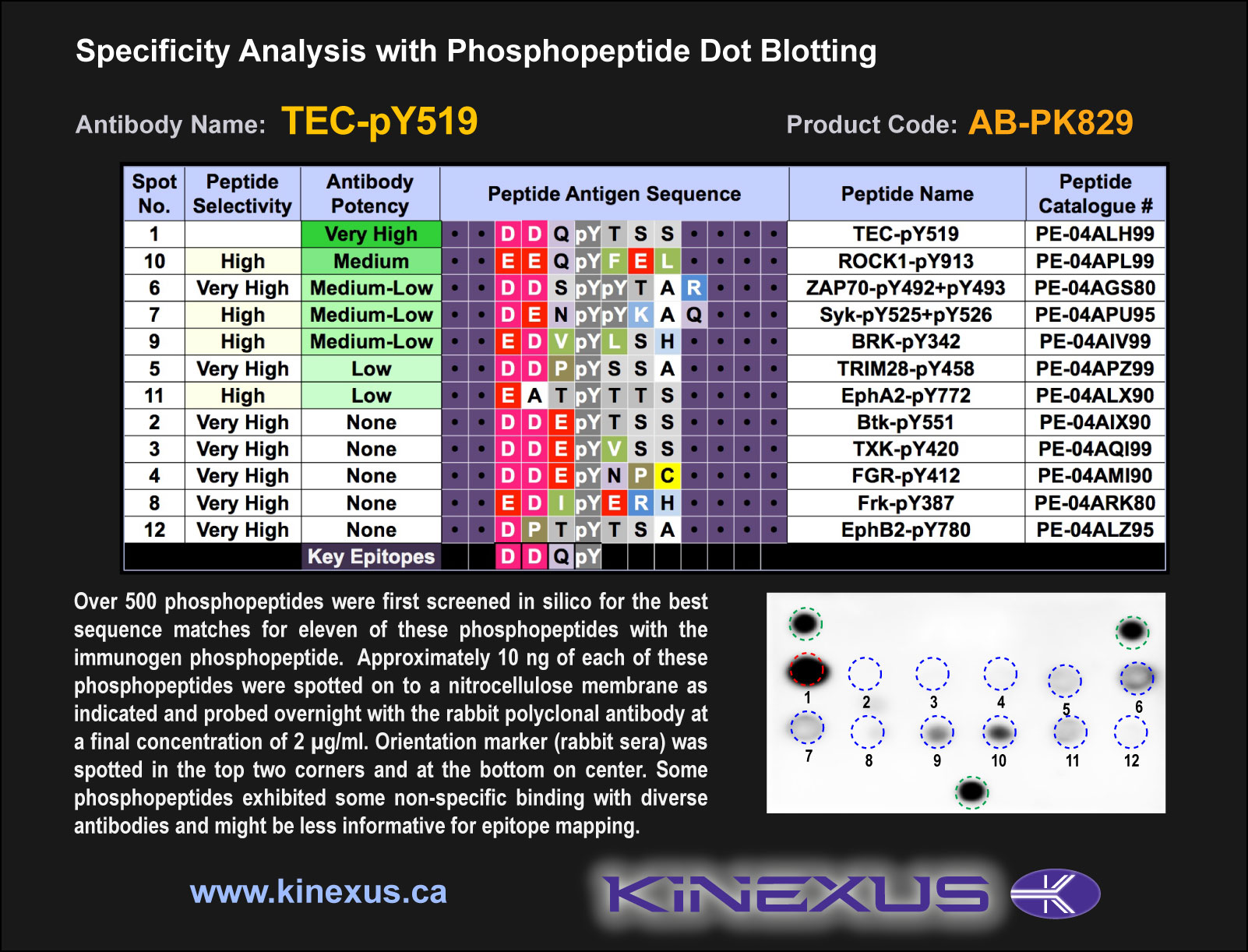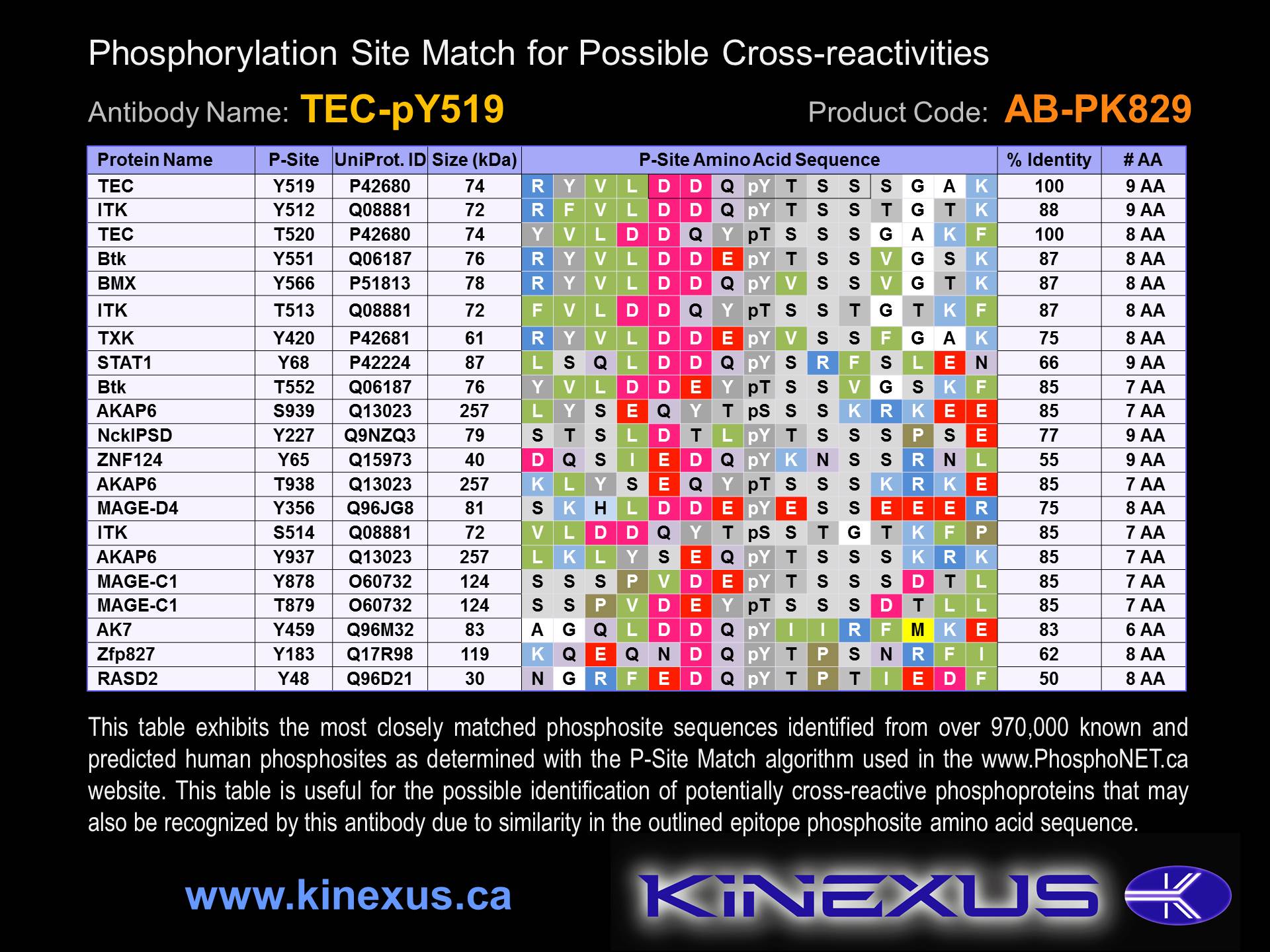Product Name: TEC-pY519
Product Number: AB-PK829
| Size: | 25 µg | Price: | 89.00 | |
| $US |
Target Full Name: Tyrosine-protein kinase TEC
Target Alias: Kinase TEC; MGC126760; MGC126762; PSCTK4; CCDS3481.1; P42680; ENSG00000135605
Product Type Specific: Protein kinase phosphosite-specific antibody
Antibody Code: PK829
Antibody Target Type: Phosphosite-specific
Antibody Phosphosite: Y519
Protein UniProt: P42680
Protein SigNET: P42680
Antibody Type: Polyclonal
Antibody Host Species: Rabbit
Antibody Immunogen Source: Human TEC sequence peptide Cat. No.: PE-04ALH99
Target Alias: Kinase TEC; MGC126760; MGC126762; PSCTK4; CCDS3481.1; P42680; ENSG00000135605
Product Type Specific: Protein kinase phosphosite-specific antibody
Antibody Code: PK829
Antibody Target Type: Phosphosite-specific
Antibody Phosphosite: Y519
Protein UniProt: P42680
Protein SigNET: P42680
Antibody Type: Polyclonal
Antibody Host Species: Rabbit
Antibody Immunogen Source: Human TEC sequence peptide Cat. No.: PE-04ALH99
Antibody Immunogen Sequence: DDQ(pY)TSS(bA)C
Antibody Immunogen Description: Corresponds to amino acid residues D516 to S522; In protein kinase catalytic domain activation T-loop between subdomains VII and VIII.
Antibody Immunogen Description: Corresponds to amino acid residues D516 to S522; In protein kinase catalytic domain activation T-loop between subdomains VII and VIII.
Production Method: The immunizing peptide was produced by solid phase synthesis on a multipep peptide synthesizer and purified by reverse-phase hplc chromatography. Purity was assessed by analytical hplc and the amino acid sequence confirmed by mass spectrometry analysis. This peptide was coupled to KLH prior to immunization into rabbits. New Zealand White rabbits were subcutaneously injected with KLH-coupled immunizing peptide every 4 weeks for 4 months. The sera from these animals was applied onto an agarose column to which the immunogen peptide was thio-linked. Antibody was eluted from the column with 0.1 M glycine, pH 2.5. Subsequently, the antibody solution was neutralized to pH 7.0 with saturated Tris.This antibody was also subject to negative purification over phosphotyrosine-agarose.
Antibody Modification: Unconjugated. Contact KInexus if you are interest in having the antibody biotinylated or coupled with fluorescent dyes.
Antibody Modification: Unconjugated. Contact KInexus if you are interest in having the antibody biotinylated or coupled with fluorescent dyes.
Antibody Concentration: 1 mg/ml
Storage Buffer: Phosphate buffered saline pH 7.4, 0.05% Thimerasol
Storage Conditions: For long term storage, keep frozen at -40°C or lower. Stock solution can be kept at +4°C for more than 3 months. Avoid repeated freeze-thaw cycles.
Product Use: Western blotting | Antibody microarray
Antibody Dilution Recommended: 2 µg/ml for immunoblotting
Antibody Potency: Medium-weak immunoreactivity of a target-sized protein by Western blotting in HepG2 cells. Medium immunoreactivity with immunogen peptide on dot blots.
Antibody Species Reactivity: Human
Storage Buffer: Phosphate buffered saline pH 7.4, 0.05% Thimerasol
Storage Conditions: For long term storage, keep frozen at -40°C or lower. Stock solution can be kept at +4°C for more than 3 months. Avoid repeated freeze-thaw cycles.
Product Use: Western blotting | Antibody microarray
Antibody Dilution Recommended: 2 µg/ml for immunoblotting
Antibody Potency: Medium-weak immunoreactivity of a target-sized protein by Western blotting in HepG2 cells. Medium immunoreactivity with immunogen peptide on dot blots.
Antibody Species Reactivity: Human
Antibody Positive Control: The observed molecular mass of the processed target protein on SDS-PAGE gels is reported to be around 65-75 kDa.
Antibody Specificity: High
Antibody Cross Reactivity: Some weak cross-reactivities in HepG2 cells, but no significant cross-reactivities in Jurkat cells and sea star oocytes.
Related Product 1: TEC-pY519 blocking peptide
Antibody Specificity: High
Antibody Cross Reactivity: Some weak cross-reactivities in HepG2 cells, but no significant cross-reactivities in Jurkat cells and sea star oocytes.
Related Product 1: TEC-pY519 blocking peptide
Scientific Background: TEC is a non-receptorprotein-tyrosine kinase of the TK group and TEC family. It is an important component of T cell signalling and T cell activation in the adaptive immune response. When T-cells or B-cells receptors are activated, this leads to the recruitment of TEC to the cell membrane, where it is phosphorylated at Y519. It regulates the development, function and differentiation of conventional T-cells and nonconventional NKT-cells, and osteoclast differentiation. It phosphorylates DOK1, one CD28-specific substrate, and contributes to CD28-signalling. It mediates signals that negatively regulate IL2RA expression induced by TCR cross-linking. It plays a redundant role to BTK in BCR-signalling for B-cell development and activation, via phosphorylation of STAP1. It is involved in both growth and differentiation mechanisms of myeloid cells through activation by the granulocyte colony-stimulating factor CSF3, a critical cytokine to promoting the growth, differentiation, and functional activation of myeloid cells. TEC phosphorylates GRB10. TEC is involved in G protein-coupled receptor- and integrin-mediated signallings in blood platelets. It plays a role in hepatocyte proliferation and liver regeneration and in HGF-induced ERK signalling. SOCS1 is an inhibitor of TEC kinase activity. TEC is a major binder of dasatinib, which is used for BCR/ABL-positive CML treatment.
Figure 1. Epitope mapping of TEC-pY519 antibody with similar phosphopeptides on dot blots.
Figure 2. Identification of phosphosites related to TEC-pY519.
© Kinexus Bioinformatics Corporation 2017



